Looking at tofu
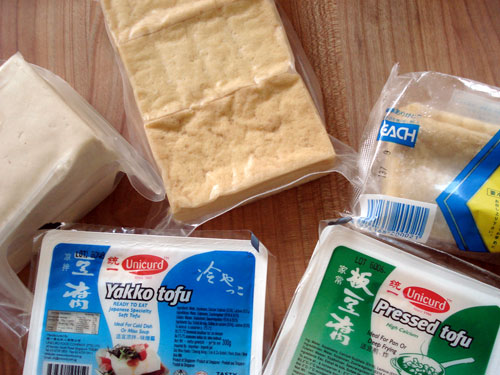
(Periodically I like to dust off an article from the vast Just Hungry archives, give it a little facelift, and present it on the front page again. I wrote this guide to tofu back in September 2008. I think it will answer most, if not all, your questions about Japanese-style tofu and related products. Enjoy!
There are several tofu recipes both here in Just Hungry as well as on Just Bento, and I've even shown you how to make your own tofu from scratch. However, up until now I have never really tried to explain the differences between types of tofu, when to use them and how to store them. Well now is the time to fix that.
Fried tofu type 1: Aburaage
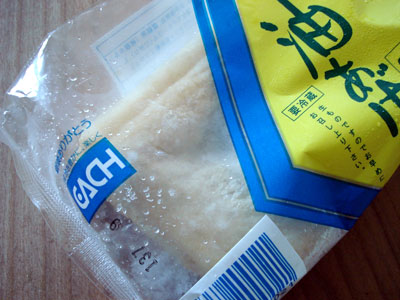
Aburaage (油揚げ)is deep fried tofu, where almost none of the soft white tofu remains. It's also called tofu skin or tofu pocket sometimes. When the tofu is deep fried, an air pocket is formed inside which can be stuffed, as in inarizushi or eggs in treasure bags. Besides stuffing it, you can use aburaage sliced up and put into soups or stir-fries, gently cooked whole in a broth as in kitsune udon, and more.
To get rid of the excess oil on the surface, blanch aburaage in boiling water for a couple of minutes, then drain away. To loosen it up so that it's easier to stuff, roll a round chopstick over the surface several times after blanching to loosen it up, then cut open.
The best way to store aburaage for longer than a few days is to freeze it. (The bag in the photo is actualy frozen.)
Japanese aburaage is always a rectangular sheet, but you can get small puffs or squares in Chinese markets.
Note: Don't confuse aburaage with canned (or packaged) inarizushi (or 'bean bag' sushi) skins, which have been cooked in a sweet-salty sauce. That is just one way to prepare aburaage. The canned inarizushi skins do tend to be rather high in salt, sugar and MSG, though they are very convenient to use. See how to make inarizushi from scratch, using plain aburaage.
Fried tofu type 2: Atsuage or namaage
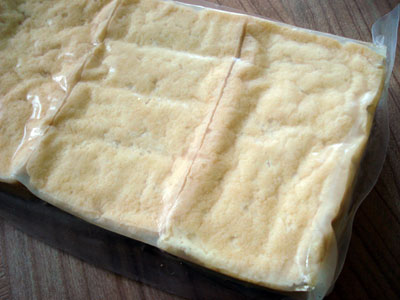
Atsuage (厚揚げ)or namaage (生揚げ)is a block of tofu that has been slowly fried in oil until it forms a slightly crinkly pale brown skin. It's stil white tofu inside though, unlike aburaage. You can get rid of the excess oil on the surface just like with aburaage, by blanching it in boiling water. Aburaage is a very versatile food, that can be pan-fried or grilled like a steak, cut up and used in stir-fries or stewed, put into soups and so on. I like using aburaage in bento recipes a lot - because it has less moisture than non-fried tofu, it keeps longer.
The two main types of plain tofu
Finally we get to plain tofu. Plain tofu can be divided into two main types: silken or kinugoshi (絹ごし), and firm or pressed. In Japanese firm tofu is called momen (木綿)or cotton tofu. Here are a block of each: silken on the left, and firm/cotton on the right.
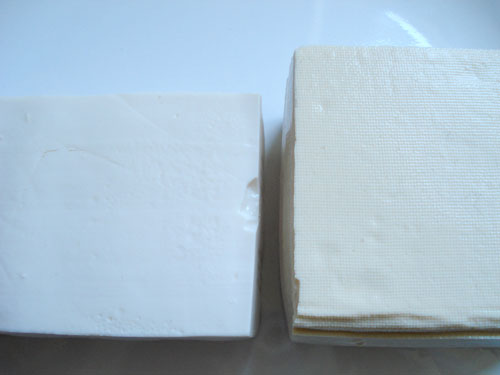
Here are the blocks from the side:
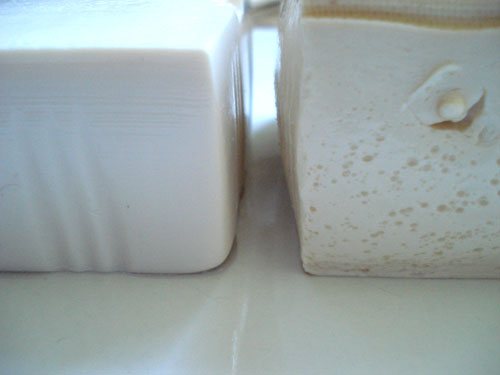
As you can see, the silken tofu is smoother and more watery, while the firm/cotton tofu is well, firmer and denser. Since silken tofu is much softer (higher water content), it is harder to handle if you want the tofu pieces to not fall apart. So if you are a tofu beginner and you want to use it on stir-fries or things like bacon wrapped tofu, you will want to use firm tofu. Firm tofu is less liable to fall apart, especially if you drain off the water a bit. Some recipes call for extracting even more water from the tofu (see using tofu for bento friendly recipes). On the other hand, silken tofu is more suited for recipes that call for it to be pureed, such as quick tofu pudding and baked squash and apple pudding, or in smoothies. I prefer silken tofu in miso soup, though firm is fine too.
Some other tofu types not pictured here
I don't have these on hand so pictures are missing...
Yaki dofu (焼き豆腐)is firm tofu that's been grilled on the outside, giving it a nice flavor.
Kouya dofu (高野豆腐)is freeze-dried tofu that is sold in the dried food section. It looks like little dried beige sponges. This is reconstituted in water before stewing. It can be a good pantry staple because it keeps indefinitely. Update: All about kouya dofu
Yuba (湯葉) is a Kyoto speciality. Thin films of tofu are scooped off the top of vats of warm soy milk. It's available in dried form and is usually used in soups and such. Fresh yuba made from fresh warm soy milk is considered a great delicacy and is usually eaten with a litle soy sauce, yuzu juice and such.
How to keep tofu fresh
Once you open the vacuum sealed pack the tofu comes in, any leftovers must be stored in an airtight container in the refrigerator, immersed in water. You will need to change the water every day too, but in any case don't keep opened tofu for more than 2 or 3 days. (With homemade tofu the shelf life is even shorter - a maximum of 2 days.) If you leave tofu out of water for more than a day in the fridge, it will take on a sour taste, not to mention picking up stray refrigerator smells! It is possible to freeze tofu (see frozen tofu cutlets) but the texture will change.
As mentioned above, aburaage can be frozen. Firm atsuage can also be frozen, though the inner texture will change a bit.
Calories in tofu products
Per 100 grams or about 3.5 oz:
- Aburaage: 386 calories (one piece is about 20-25g) This is the calorie count before getting rid of the surface oil, so after it's cooked it would be a bit lower in calories.
- Atsuage: 150 calories - (one piece is anywhere from 100 to 200g, depending on the brand etc.) This is the calorie count before getting rid of surface oil.
- Silken tofu: 56 calories
- Firm/cotton tofu: 72 calories
- Yaki dofu: same as firm tofu
- Kouya dofu (dry weight): 590 calories
- Kouya dofu (cooked weight): 130 calories
- Yuba (cooked weight): 150 calories
What about those stories I hear about soy being good for you/bad for you?
Whenever I write about soy or tofu products here, I usually get some comments or emails about how soy products are either bad for you (the current trend - makes men grow breasts and so on) or good for you (prevents certain types of cancer and what have you).
My attitude about these types of reports is this: Tofu has been eaten for hundreds or thousands of years. Generally speaking soy products are a great source of vegetable based protein and fat. And in any case, no one should be eating massive quantities of any one food product every day of the week, as seems to be the case with those reports of body builders taking lots of soy protein powder and sprouting boobies and such. Even the most die hard tofu fan in Japan, like my mother, does not eat tofu every single day. (For what it's worth, she has IBD and finds tofu to be one of the few easily digestible proteins.) Variety is the spice of life, and your diet! See also: A problematic report on the dangers of soy.
Hopefully most if not all of your tofu related questions have been answered here. If not, ask away in the comments!
See also
- How to make your own ganmodoki - a kind of tofu fritter that's available in packaged form, but is much better when freshly made
- Tofu from bean to plate - a small family-run company in Kyoto that makes tofu and also runs a wonderful tofu-kaiseiki restaurant. Includes pictures of special types of tofu and soy milk - tofu at its best!


 Welcome to Just Hungry, where we serve authentic Japanese recipes and more! I'm
Welcome to Just Hungry, where we serve authentic Japanese recipes and more! I'm 














Comments
Jo
4 September, 2008 - 13:08
Permalink
aburaage
Hi Maki, can I ask you 2 tofu questions? :)
and
Jo
maki
4 September, 2008 - 13:51
Permalink
The canned aburaage is
The canned aburaage is cooked specifically for use as inarizushi pockets, and it's cooked in a mixture of soy sauce, mirin and sugar (the sweetness comes from the sugar and mirin). It's fine unless you are very concerned about the sugar content. As long as you drain it off and don't drink the sauce in the can or something (I know some people who do this...) , it's not that much.
aa
4 September, 2008 - 14:42
Permalink
I buy Pulmone tofu – a
I buy Pulmone tofu – a Korean/American brand closest in taste to the kind I used to buy in Japan – from natural natural. Oddly, it has an unusually long shelf-life – usually about a month. I'm sure the fresh tofu I used to buy was good for about a week, maybe two, before being opened; I just wonder how this brand, which is flown in from America and is supposedly organic, manages to remain fresh for a month.
Are there any additives you are aware of, natural or artificial, that prolong the freshness of tofu? (Note: the Pulmone tofu I buy isn't like the carton tofu which I know can be stored for much longer, but doesn't taste nearly as good imho – these kinds are typically used for desserts, aren't they?
maki
5 September, 2008 - 07:57
Permalink
I believe that the
I believe that the difference these days in 'fresh' tofu is the packaging, which eliminates air and vacuum seals it. That's why it has a much longer shelf life. And I agree that carton tofu just doesn't taste right. (They do have firm and silken carton tofu, but neither tastes right to me.)
Reiko
4 September, 2008 - 17:14
Permalink
Yuba
I love yuba but I can't really get it here anymore. There used to be a great little family owned shabu-shabu restaurant in my area and they made this really great yuba dish where they took a sheet of yuba and wrapped it around steamed and shelled edamame. It was lightly toasted so it was crispy on the outside and it was served with a sesame miso sauce. It was one of my favorite things ever! I would attempt to make it myself but none of my local asian markets carry yuba, sadly.
maki
5 September, 2008 - 08:00
Permalink
I agree yuba is really
I agree yuba is really delicious! None of my local markets carry it either, and neither does Japan Centre. My mother has tried shipping it to me from Japan, but by the time it gets here it's so delicate that it's been crushed into crumbs! Nama-yuba is possible though - just heat up additive-free soy milk, and slowly skim off the 'skin' that forms on top. Delicious!
Reiko
11 September, 2008 - 17:07
Permalink
Good idea!
Thanks for the tip! I will have to try that!
Rina
4 September, 2008 - 21:27
Permalink
self-made aburaage?
If I were to deep-fry long slim pieces of firm tofu, would that result in semi-decent aburaage?
maki
5 September, 2008 - 07:55
Permalink
I did try making aburaage a
I did try making aburaage a couple of times, slicing homemade tofu, and while I did get that nice crust, they never formed proper air pockets inside. I did read in a Japanese magazine that a special process is used to make them form the air pocket - if only I could find out what that is (and whether is reproducable at home!) But homemade atsuage does turn out ok and it's delicious.
anonymoushirumaui
3 January, 2014 - 08:13
Permalink
Re: I did try making aburaage a
I wonder if using a syringe or one of those skinny coffee stir-stick straws and blow air inside into many little pockets?
Marie
6 September, 2008 - 17:10
Permalink
Silly question ahead
Beware of the silly question... But I was wondering, could you use cotton and silken tofu alike for Hiyayakko ?
Most of the time I've rather seen silken tofu... but sometimes the tofu comes in blocks in photos of hiyayakko, so I was wondering ^^
maki
8 September, 2008 - 10:40
Permalink
Hiyayakko
It's not a silly question at all! You can use either silken or firm tofu for hiyayakko - the key is to use tofu that is as fresh as possible. It's like tofu sashimi if you think about it. Nowadays I can't eat regular tofu as hiyayakko anymore, since I've taste freshly made tofu this way.
Chinalilly
8 September, 2008 - 04:12
Permalink
I’m wondering what Yuba
I'm wondering what Yuba is? It sounds a lot like Chinese tofu skin or dried beancurd, which is one of my favourite ingredients. You can usally get it at Chinese grocery stores in dried form. In Hong Kong, you can get fresh, which is delicious, but I'm still happy with the dried version.
Lizzie
9 September, 2008 - 20:12
Permalink
I love tofu
and up until recently I was doing a 'Tofu Tuesday' feature on my blog. It was incredible how many people say "I don't like tofu" - there are so many different types and ways of preparing it that I find it hard to believe that this could be true.
I particularly like the Chinese fermented white tofu to stir-fry vegetables in, and also the tofu puffs my grandmother used to stuff with fish paste and serve with black bean sauce. On the Japanese front, I don't know many recipes at all, but Agedashi Tofu comes top so far.
Pat
9 September, 2008 - 21:51
Permalink
I love tofu, too!
I got to check out your tofu recipes! Believe it or not, I didn't like tofu at all as a kid. I grew up in Thailand and I remembered tofu being kind of smelly. I guess it's not something we eat a lot there and we don't specialize in it. The only kind I could tolerate was the silken tofu in clear soup. I think people who say they don't like it just haven't had good tofu.
Pat
9 September, 2008 - 21:43
Permalink
Yuba
I'm also wondering if there's a difference between Japanese yuba and the Chinese variety. I shop at both Japanese and Chinese markets and noticed that the Japanese kind is very expensive. It can cost as much as 5-8 times more. Is there something special in making? If someone can tell me the difference, I won't have to splurge $15/pack just to try.
anon.
19 February, 2009 - 17:02
Permalink
Re: Looking at tofu
Unicurd is made in Singapore! Nice to know that Singaporean tofu products have reached Switzerland! =)
anon.
5 May, 2009 - 17:09
Permalink
Re: Looking at tofu
Regarding health issues/benefits in tofu:
The only health issue (the origin of the "makes men grow breasts" myth) is that soy is a plant with a high content of plant estrogen. Yes, plants have hormones, and many of them are almost exactly like human ones. This is not a problem for the average person and may even help some people (it would, in fact, help reduce the risk of uterine cancer). However, in people who are already at risk for estrogen related cancer (read: breast cancer) ingesting such foods is not really a good idea.
So, fine for most people, problematic for a few.
Nadia
27 May, 2009 - 20:25
Permalink
Re: Looking at tofu
Hi! I was wondering I bought tofu from my local Asian food market (H mart coolest store ever =)) it was their store brand i was wondering if i could eat it raw i`m not exactly sure how long ago it was made. I really wanted to make the Hiyayakko you made! it look and sounds really good.
thank`s in advance =)
maki
27 May, 2009 - 22:29
Permalink
Re: Looking at tofu
If it's been sealed airtight and is before its expiry date, it should be safe to eat without cooking. You may want to put it into fresh water (draining away the water that's in the plastic container), and let it sit for awhile first.
Ricardo
16 July, 2009 - 02:16
Permalink
Re: Looking at tofu
Im looking for the "canned" abura'age that are the skins to fill with home made Inari /exasperated from searching ...
would like to acquire thru mail.... Please advise.
Peggy Preston
17 July, 2009 - 12:45
Permalink
Re: Looking at tofu
I am looking for a basic fried tofu dish to make with packaged (firm) tofu, the kind that is sold in general supermarkets. I had a very good experience at a salad bar when Japanese were running a college cafeteria: the tofu looked like oblong shapes and had a firm outside but soft center, not really a pocket though, just puffy. It was served in a VERY savory darkish sauce with fresh sliced onions, bulb onions, not green onions. It was very delicious with the orange slice and fresh spinach salad I made to go with it. I would love to make it--have been dreaming how to for over 10 years now...any help what it was and how to make it? 10-Q!
paulw.
30 September, 2009 - 23:35
Permalink
Re: Looking at tofu
The fried tofu in the top pic (EACH?), and the other fried ones in the Japan Centre and the shops in Brewer St in London England all have GMOs listed in their ingredients. Is this a new development? I'd rather not have them.
Can't find fried tofu in my local health food shops in London, only odd flavoured ones, and smoked, or just the plain stuff.
Great blog
tofuforbeginners
8 October, 2009 - 19:10
Permalink
Re: Looking at tofu
Very detail look in, it is a fantastic post.
I never know there so many different kind of tofu.
Thanks for the info, I learn something to day, great start for tofu for beginners
Luney
24 February, 2010 - 01:32
Permalink
Re: Looking at tofu
Thank you so much for breaking down the differences in tofu! I haven't been able to get the real skinny on tofu, and I wasn't aware that there so many kind besides aburaage and the stuff you buy at a western supermarket.
I'm so glad I found your blog. I've heard mention of you on other cooking blogs I follow, but I'm sorry to say that I've never clicked the link until now. I'm just a hapa kid and my Dad's from Japan, and I know he misses the tastes. I have no idea what Real Japanese Food is supposed to taste like, other than "good". Since you're not a cookbook author trying to appeal to western sensibilities where asian food is concerned, I'll be sure to come back to your blog regularly for recipes and tips. Thanks!
BL
6 May, 2010 - 23:52
Permalink
Re: Looking at tofu
I think it's a blessing that tofu products exist. I don't believe it's unhealthy for you, unless maybe if you eat unhealthy amounts of it.
When I started doing my groceries at an organic store I discovered tofu products are very popular there. They sell most kinds of tofu. Soy is one of the things that is famous for being genetically modified, which I don't have a good feeling about, so I rather buy it there.
I'm not too strict though as the organic store doesn't have abura-age, so I still buy that at a Japanse/Korean mart.
Chee Ann
6 June, 2010 - 23:19
Permalink
Aburaage Question
Your blog is such a useful resource -- it's helped me many times! I have a question about aburaage.
I bought some aburaage about two weeks ago, but I didn't realize that I should freeze it if I wasn't going to use it right away. (There was no expiration date.) Do you know how I can tell if it's gone bad?
I buy soy / tofu puffs from my local Chinese grocery store and they have an expiration date that's usually a couple weeks in the future, so I was assuming that aburaage had approximately the same shelf life :\
maki
7 June, 2010 - 19:19
Permalink
Re: Aburaage Question
If the bag is vacuum sealed, the aburaage may be okay...but if it's just stapled or taped shut they may have gone bad. Open it up and take a good whiff - if they smell rancid (like old oil) or sour, they have gone bad, but if they smell okay they should be fine.
anon.
12 November, 2010 - 10:11
Permalink
tofu mysteries solved - thank you!
I've been trying to figure out the mystery of tofu for years. Thank you for this concise beginners guide.
AikoVenus
23 June, 2011 - 00:19
Permalink
Re: Looking at tofu
Oh, I never thought of rubbing a chopstick over the aburaage to loosen it up. I make it all of the time and "wash" it with boiling water after I let them rest after the first frying session. Thank you so much!
anon.Laura
6 July, 2014 - 15:51
Permalink
Re: Looking at tofu
Hi! What a great post! I have just stocked up on inarizushi as there are no Asian stores near me - are they ok to freeze as there are quite a lot in a single pack so would probably only use half.
Dezine
23 August, 2015 - 02:29
Permalink
I found firm silken Tofu in the supermarket
To start with thank you for your wonderful, inspiring websites. About the tofu, I am confused. In the local (rather big) Asian supermarket and our local XL regular supermarket, they sell tofu always called "silken" but with the varieties firm and soft. Brand "Unicurd" sells "silken tofu" red (is soft) and green (is firm). Morinoga is a brand with "mori-nu silken tofu" (on the shelf, not the regrigeration section) with big letters FIRM. I am confused! According to your info, "silken" is per definition not "firm". Can you help me out? Thanks!